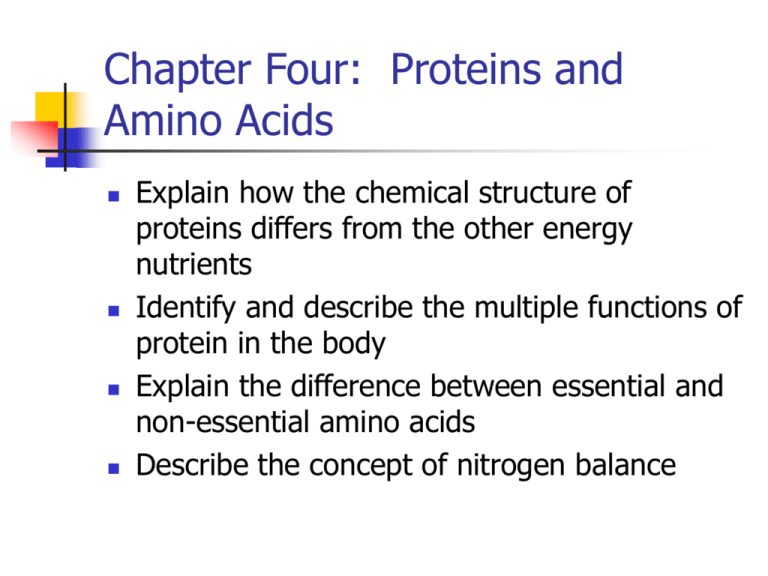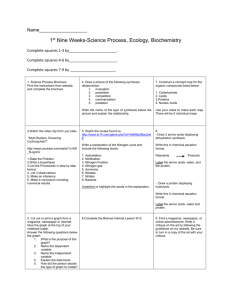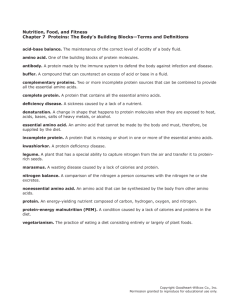NORMAL NUTRITION NURP 102 ANDERSON
advertisement

Chapter Four: Proteins and Amino Acids Explain how the chemical structure of proteins differs from the other energy nutrients Identify and describe the multiple functions of protein in the body Explain the difference between essential and non-essential amino acids Describe the concept of nitrogen balance Proteins cntd. Describe conditions associated with either positive or negative nitrogen balance Describe causes and characteristics of marasmus and kwashiorkor Explain what makes a protein complete and identify sources of them Explain the types of vegetarian diets What do you already know? Proteins in Review Energy provided: 4 kcal per gram 12-15% of calories per day Sources in the Food Guide Pyramid Bread, Cereal, Rice and Pasta Group Vegetable Group Milk, Yogurt and Cheese Group Meat and Meat Alternates Group Chemical View of Protein Contains same elements as other energy nutrients (carbon, hydrogen and oxygen) plus nitrogen Made up of building blocks called amino acids (20 amino acids) Essential amino acids must be supplied in foods (9 are essential) Non-essential am. acids—body can make Nutritional Role of Proteins Primary function is to Build, Maintain, and Repair the Body — not to provide energy Enzymes: catalysts that facilitate chemical reactions Anabolic—build body compounds Catabolic—dismantle body compounds Example—digestive enzymes Nutritional Roles cntd. Fluid and Electrolyte Balance Help maintain distribution of fluids in the body Proteins are hydrophilic—water loving Acid-Base Balance Controls blood pH (acidity or alkalinity) Release or bind hydrogen ions Protein roles cntd. Antibodies Hormones Formed from protein Maintains resistance to disease Messenger molecules Examples are insulin and thyroxin Transport—carry other nutrients, e.g. oxygen, lipids, vitamins and minerals Protein Roles cntd. Nitrogen Balance—maintenance of same amount of protein in body tissues Positive Balance—nitrogen in > nitrogen out Growing children Pregnant woman Negative Balance—nitrogen in < nitrogen out Fasting or starvation Severe traumas—burns, tissue loss Protein Roles cntd. Zero balance Nitrogen in = nitrogen out Normal daily functioning Measured by sample of body tissue or urine Protein Deficiency Marasmus Energy deficiency common in young children ages 6-18 months Food is low in kcalories and protein Kwashiorkor: (Red hair) Protein deficiency common in children after age two—after weaning Symptoms: edema, distended abdomen and orange hair Proteins in Foods Complete Proteins: Contain all essential amino acids Sources are animal foods with the exception of gelatin Incomplete Proteins: Limited in amounts or number of essential amino acids Sources are grains, vegetables and legumes Protein Sparing Carbohydrate needed to spare protein from being used for energy If protein is used for energy it is deaminized—nitrogen is removed—and the C, H, and O are used for energy Low carbohydrate diets are not recommended for this reason Vegetarian Diets Vegetarianism: rely mostly on non animal foods for their diet Levels of Vegetarianism Lacto-vegetarians—milk only Lacto-ova—milk and eggs Vegans—exclude all animal products Advantages: Easier to maintain desired weight Lower cholesterol and higher fiber foods Lower rates of colon cancer and heart disease Better digestion—low fat and high fiber Vegetarian Pyramid Vegetarianism cntd. Nutritional concerns Vitamin B12 only found in animal products Vitamin D mainly available in milk and animal fats Iron and Zinc are not as available in non-animal sources TEST Questions 1. Proteins are chemically different from carbohydrates and fat because they also contain: A. B. C. D. Phosphorus Sodium Iron Nitrogen Test Questions 4. The basic building blocks of protein are: a. glucose units b. amino acids c. side chains d. saturated bonds









